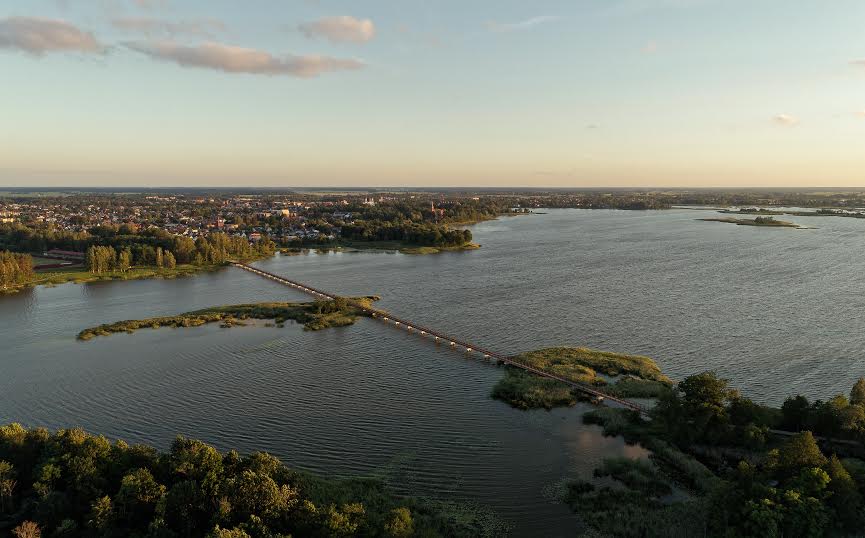

Astravas Manor
Astravas is a borough of the city of Biržai, which is situated on the northern shore of the Širvėna Lake at the River Apaščia.
In 1811, the Duke Dominykas Radvila sold the estate of Biržai to the Count Mykolas Tiškevičius, but only in 1844 after prolonged litigation the fact was validated legaly. Unwilling to rebuild a ruined fortress, the new owners decided to build a mansion-house on the opposite shore of ŠirvėnaLake. In 1862, counts of Biržai have built a two-storey palace with a belvedere on the top of the building. A Neoclassical palace built in the style of Italian villas is one of the most magnificent manors of Romantic era in Lithuania. Besides the palace, the manor complex included stables, a dog-keeper’s house, a mill, numerous outhouses, and a dam-bridge built in 1860, which retained the waters of Širvėna Lake until 1986.
Decorative sculptures of lions brought from Sankt Petersburg that stood at the entrance to the manor were replaced with cement copies, with the original bronze sculptures being moved to the Vytautas the Great War Museum in Kaunas in 1938. The manor complex had a large classical park with many tiny artificial lakes. The palace housed a large portion of archives of the Radvila and Tiškevičius families, a library with collections of books (15th – 17th centuries), archaeology, ethnography and art items, before being transferred to Vilnius and Paris at the end of 19th century and the beginning of 20th century.
In the 20th century, Astravas Manor has been used for various industries. In 1924, a dairy was opened, soon to be replaced by a factory of burlap bags and packthreads, and, in 1930, by a linen factory Siūlas, in place until now. In the years 1956 to 1965, Astravas palace and a major part of the park has been restored and renewed. In 1987, the footbridge across the lake between the manor and the city has been rebuilt.
Astravas manor bridge – dam. The bridge – dam was built in 1860, until 1986 it kept the waters of Lake Širvėna. The arched dam was built in Astravas in 1860 by Count Jonas Tiškevičius. In 2005, it was restored. The Astravas bridge – dam is added to the Register of Protected Cultural Values as a part of the Astravas Manor complex. There is currently a new dam that is in use and the old one is preserved as a cultural heritage. However, some Širvėna Lake water still flowing through the old dam.

Pedestrian Bridge over Lake Širvena
Širvėna Lake is the oldest artificial water body in Lithuania. In 1575, it came into existence following the building of a dam across two rivers running through Biržai for protection of both the fortress and the city. Stretched over a swampy area of nearly 400 hectares, the pond reliably protected the castle and the city from the north. Nowadays, the area of Širvėna Lake is around 325 hectares.
Following the establishment of a linen factory in buildings of Astravas Manor in 1928, a 525-metre-long and 2.45-metre-wide footbridge has been built over Širvėna Lake to connect the Astravas Manor and the city of Biržai. In 2019, the bridge was completely renovated.
It is the longest footbridge across a lake in Lithuania. Today, the footbridge is very popular with anglers and newlyweds, local people and visitors. It is a great place to admire views of the city, savour the calm tranquillity of the lake, and take a stroll to Astravas Manor.
BIRŽAI CASTLE
Biržai Castle is a Dutch-style fortress with bastions built by the Duke Radvila family and used to defend Lithuania’s northern borders in the 17th-18th centuries. In 1978-1988, a dilapidated palace of the castle complex has been restored. Today, it houses Jurgis Bielinis Public Library of Biržai from 1988, and Biržai Regional Museum Sėla, from 1989.
BIRŽAI REGIONAL MUSEUM “SĖLA”
Biržai Region Museum “Sėla” is situated in the palace and arsenal. The whole complex consists of the rebuilt palace, arsenal, bridge, two gunpowder rooms and ruins of the gate and the fortification building.
The collections represent the culture and history of Biržai region. You will have a chance to get acquianted with the archeological finds from the era of Selonian and Semigalian tribes, the period of the dukes Radziwill and counts Tyszkiewicz. You will be able to learn about life in Biržai in the 18th to the second half of the 20th century. Equally interesting and valuable are the exhibitions on the history of the religious confessions of Biržai region, art and ethnography. There is an interactive warfare exhibition focusing on the 16th, 17th and 18th century on display in the arsenal.
The museum invites you to visit the exhibition of ancient brewing traditions and to take part in their special program “From a grain to a song: Biržai tradition and hospitality”. This is a unique opportunity to experience the hospitality of Aukštaitija region and see the ancient brewing equipment. The museum also organizes a wide range of educational programs and workshops for schoolchildren of all ages.
Museum’s two temporary exhibition halls host a new exhibition every 3 to 4 weeks.
MUSEUM COLLECTIONS
The museum “Sėla” boasts sizable collections which are on display in the palace (Prehistory, Ethnography, Religion, Biržai and the Radziwiłł family, Biržai in the 19th century, Biržai in the 20th century) and arsenal (houses a permanent warfare exhibition since 2014).
